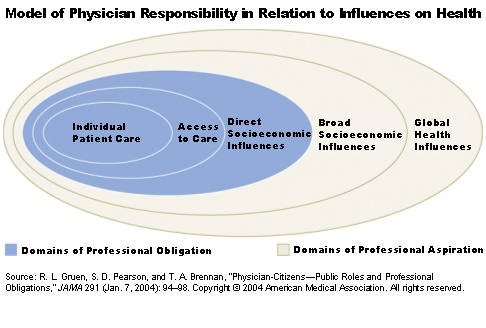In recent years, health care leaders have urged physicians to become more involved in the public arena in order to cultivate public trust and address community-based causes of ill health. But medical education and the practice environment have not fostered such engagement, and physicians' public roles have not been clearly defined.
A recent article in the Journal of the American Medical Association creates a framework for discussing physicians' public engagement. In "Physician-Citizens—Public Roles and Professional Obligations" (Jan. 7, 2004), lead author Russell L. Gruen, who was supported by The Commonwealth Fund as a 2002–03 Harkness Fellow at the Harvard School of Public Health, attempts to bridge the gap between the rhetoric of social responsibility and the realities of medical practice.
Physicians' Public Roles
Gruen and his coauthors define physicians' public roles as advocacy for and participation in improving those aspects of communities that affect health. They point out that physicians often are in positions to track and address the influence on health of social, economic, and environmental characteristics. Physicians can document, for example, the effects of health insurance or environmental risks on their patients and contribute to knowledge of socioeconomic determinants through practice-based data collection and research.
Obligations vs. Aspirations
The authors' model conceptualizes the boundaries between professional obligations and aspirational goals (figure). The center circle represents physicians' core responsibility: to provide high-quality care to patients. The socioeconomic influences that affect patient health are organized in concentric circles around the center, reflecting their relative relationships to patients' care and to physicians' sphere of influence. For example, giving advice about smoking is part of a doctor's core mission, while taking a public stand on efforts to reduce smoking (a direct socioeconomic influence on health) would be a feasible and potentially effective role for a physician.
The non-shaded concentric circles represent socioeconomic factors that are clearly associated with health (e.g., local or global disparities in income, education, or opportunity), but for which there is less direct evidence linking them to illness in individuals. While aspirations to improve these broader health determinants are laudable, physicians' responsibilities in these domains may not be sufficiently different than those of other citizens for them to be recognized as professional obligations.
Public Agenda
The model can assist physicians in identifying a public agenda that is consistent with their expertise and interests. The authors suggest that public advocacy can range from working to improve immunization rates or enhance cross-cultural communication to engaging with others to address a health problem or advance a particular political cause.



